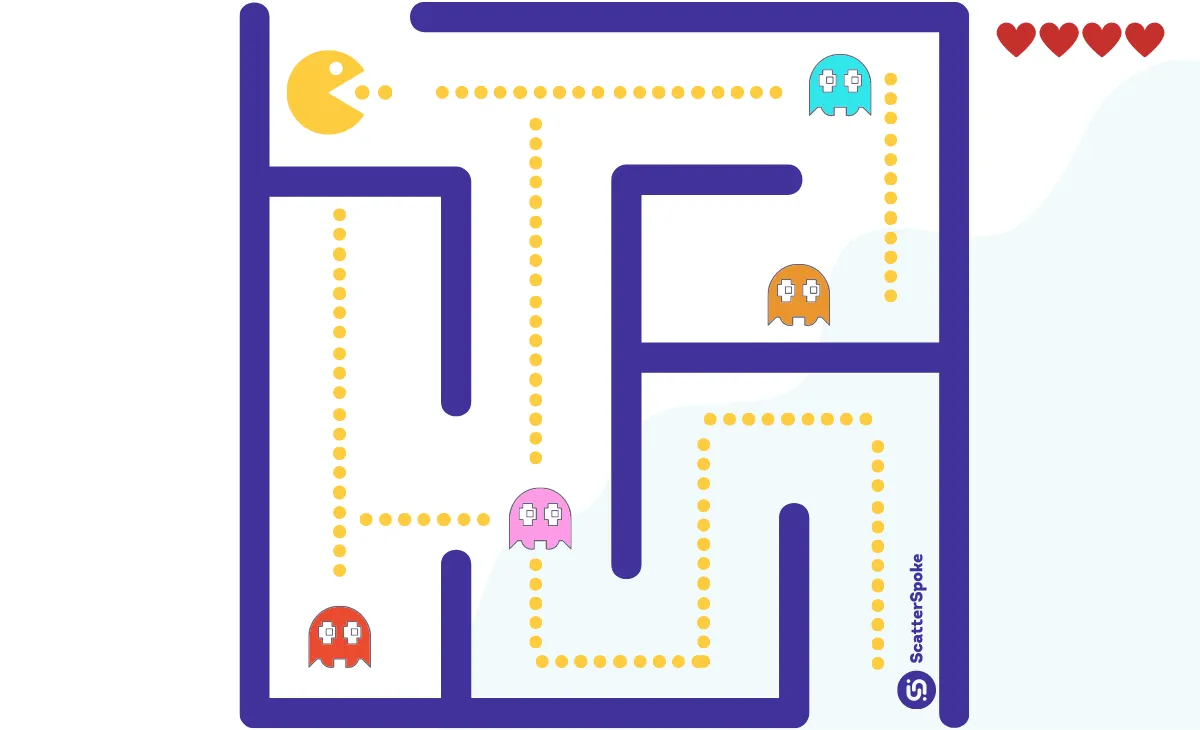
Time for another retrospective with the team. Will it be a flop? It is important to switch things up and apply different templates to your retro meetings to keep them dynamic sprint after sprint. Variety in formats and techniques support the engaging facilitation of the retrospective. After all, no one wants to do the same thing over and over again.
Kids of the 90s, this format is for you. Who didn’t love playing Pac-Man as a child? It is a simple and classic game that can keep you entertained for hours. In case you haven’t heard about it, old-school Pac-Man is an action game. The player controls a yellow circle-shaped character through an enclosed maze. The goal is to eat all of the dots placed in the maze while avoiding four colored ghosts.
You can combine business and pleasure with your team and use the Pac-man format in your upcoming retro to keep the meeting focused and relevant.
Applying this retrospective format is easy on Scrum Masters and exciting for participants.
There are 4 main areas of the PACMAN retrospective to consider in order to categorize the feedback from the group:
Pac-man – Pac-man represents the team’s attempts to eat as many dots as they can without being caught by the Ghosts. In other words, the team is trying to cover as much workload as possible as efficiently as possible without falling prey to roadblocks in the process. The Pac-man area of the retrospective board is where the members point out what they do well and what is helping them move forward with their work.
Ghosts – In the Ghosts section of the retrospective board, the team identifies the things in the last sprint that blocked them from achieving certain goals or have held them back.
Power pellets – Power pellets represent the enabling factors they discovered in the last sprint, so that they can build them more efficiently into the process in the coming active period of work. In this section, encourage team members to identify behaviors that they should be doing more of and being more consistent about if they want to experience more successful moments during future sprints.
Remaining lives – Remaining lives are aspects of the process that the team would like to do differently in the next sprint in order to avoid failure.
Use a retrospective board to categorize the group’s ideas or get creative by drawing a Pacman arena on a digital or white board canvas. The arena should include the 4 areas mentioned above and provide ample room for team members to contribute ideas without running out of space.

After choosing this format and preparing for the meeting, Scrum Masters have a role in facilitating the retrospective meeting during which the format will be used. Start by asking team members to write down notes for each category and place them on the board (digital or physical). It is best practice to set a timer to timebox the number of minutes that team members have to populate each area of the retrospective. For example, five to ten minutes might be dedicated to each section, depending on the time allocated for the entire retro.

Once everyone has chipped in with opinions and suggestions, it’s time to discuss in greater detail the identified roadblocks and ideate around action items that can be applied in the upcoming sprints.
At the beginning of the next retro, follow up with the team members on the takeaways from the previous feedback session to evaluate how the improvement process is moving along. Did we manage to make these improvements? Did we remove these roadblocks? Offer leading questions that encourage the team to think critically about the action items from their retrospective meetings.
The Pac-man retrospective brings out the nostalgia in everyone. No doubt, the team will be intrigued by this format if they’ve ever seen the Pac Man character before in a different context. Bringing the element of play into the retro experience can be a great tactic for team members to get out of their comfort zone and discuss thornier topics in a lighthearted way.
Expect for more members to take an active part in a format like this. In the end, it’s up to the Scrum Master to make sure that the conversations during the retrospective translate into meaningful action items that the group can use to continuously improve.
Ready to start applying simple yet creative formats to your regular retrospectives? Here’s one way you can do this online with your team!